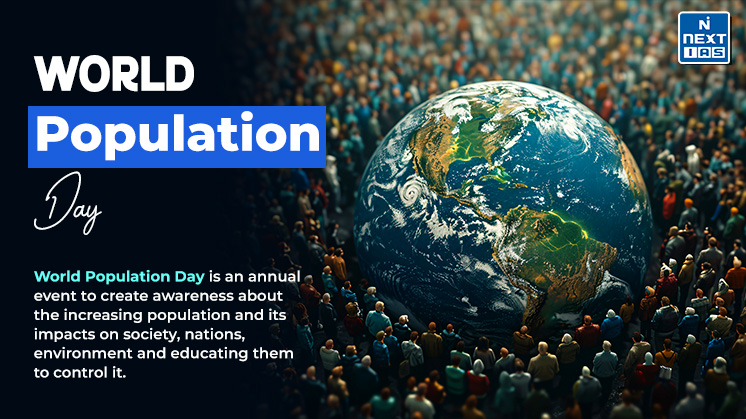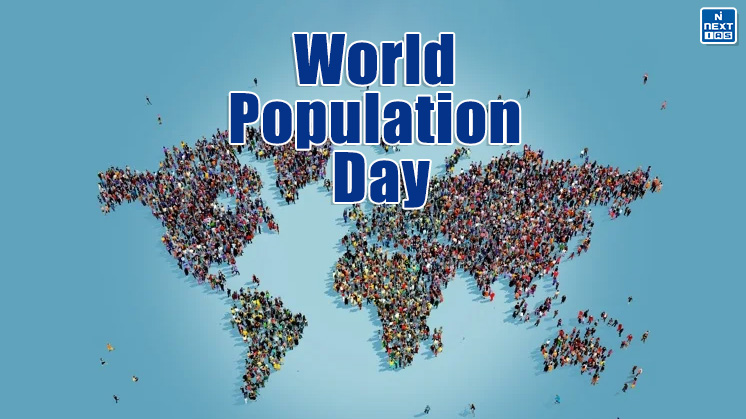World Population Day (WPD) [11 July] is the day when the world comes together to raise awareness about the complex issues surrounding population growth and its impacts on development and sustainability. Like every year, this year as well, the world is all set to celebrate World Population Day 2024 (WPD 2024) on 11th July 2024. As the world prepares to recognize and address the pressing challenges related to population, this article on World Population Day presents a detailed account of its history, key facts, objectives, theme, significance, and more.
About World Population Day (WPD)
World Population Day, also known as International Population Day is a global observance celebrated annually on July 11 to raise awareness about the complexities of global population issues. This day commemorates the “Day of Five Billion” (July 11, 1987), when the world’s population reached five billion people. The occasion also serves as a platform to appreciate and highlight the critical challenges and opportunities posed by global population trends and their impact on sustainable development, health, and well-being worldwide.

Key Facts about World Population Day
| Date | 11th July |
| Origin | This day traces its origin to the “Day of Five Billion” (July 11, 1987), when the global population reached approximately 5 billion. |
| Objective | To raise awareness about global population issues and their impact on sustainable development. |
| Theme | Theme changes annually, and is decided by the United Nations Development Program (UNDP) in coordination with United Nations Population Fund (UNFPA). |
| Theme 2024 | The theme for World Population Day 2024 is yet to be announced by UNDP and UNFPA. |
History of World Population Day
The history of World or International Population Day dates back to the 1980s. The chronology of its origins and evolution is explained below.
Day of Five Billion (1987)
- On July 11, 1987, the global population reached approximately five billion. This was a landmark moment in the world demography, drawing global attention to the rapid population growth.
- This day brought global focus to issues related to sustainable development, resource management, and the dynamics of population expansion.
- The overwhelming response and interest generated by this event underscored the need for a dedicated platform to address population issues on a continuous basis.
Establishment of the Day by UNDP (1989)
- The United Nations Development Programme (UNDP) identified the necessity for a focused approach to population issues in the wake of the attention garnered by the “Day of Five Billion.”
- Accordingly, in 1989, the UNDP Governing Council established the Day to be observed annually on July 11 (the “Day of Five Billion”)
- The objective was to promote understanding and awareness of population challenges, encouraging integration of these considerations into policies and programs.
United Nations General Assembly Resolution (1990)
- The United Nations General Assembly (UNGA) adopted Resolution 45/216 in December 1990, formally establishing the annual observance of the Day.
- This formal endorsement by the UN General Assembly solidified the Day as a key observance for raising awareness and promoting action on population dynamics.
First Celebration of World Population Day
The first World Population Day was celebrated on July 11, 1990, with participation from over 90 countries.
Present Status
- The inaugural observance in 1990 set the stage for continued international engagement and activities.
- The day has since been commemorated annually by UNFPA country offices, governments, and civil society organizations.
Celebrations of World Population Day
Here is an overview of some common types of events that take place as part of World or International Population Day Celebrations across the world:
- Awareness Campaigns – Governments, NGOs, and community organizations conduct awareness campaigns, focussed on educating the public about population trends, family planning, reproductive health, and related sustainable development goals.
- Public Lectures and Discussions – Universities, research institutions, and advocacy groups organize public lectures, panel discussions, and debates on population-related topics.
- Art and Cultural Events – Many countries organize art exhibitions, cultural performances, and competitions based on the themes of population dynamics and sustainable development.
- Health Camps and Services – In several regions, particularly in underserved communities, health camps and outreach programs are organized to provide reproductive health services, family planning counselling, and maternal healthcare.
- Youth Engagement – Youth forums, educational workshops, and campaigns are organized to engage young people in discussions and activities related to population issues.
- Community Mobilization – Local communities participate in World Population Day by organizing rallies, marches, and community clean-up drives with a focus on environmental sustainability and responsible consumption patterns.
- Partnerships and Collaborations – International organizations like the United Nations Population Fund (UNFPA), along with governments and civil society organizations, collaborate to amplify the impact of World Population Day.
Objectives of World Population Day Celebration
Some of the prominent objectives of World or International Population Day celebrations can be seen as follows:
- To increase public awareness and understanding of global population issues, including demographic trends, growth projections, and their impact on sustainable development.
- To promote access to reproductive health services, family planning information, and contraceptives to empower individuals and families to make informed choices about their reproductive lives.
- To draw attention to the challenges posed by rapid population growth, such as resource scarcity, environmental degradation, and socio-economic disparities.
- To advocate for gender equality and women’s empowerment, emphasizing the role of education, healthcare access, and economic opportunities in population management and sustainable development.
- To focus on the needs and aspirations of young people regarding reproductive health education, access to healthcare services, and opportunities for education and employment.
- To facilitate discussions among policymakers, stakeholders, and communities on effective policies and strategies for population stabilization, equitable development, and environmental sustainability.
- To align World Population Day activities with the SDGs, particularly Goal 3 (Good Health and Well-being), Goal 5 (Gender Equality), Goal 10 (Reduced Inequalities), and Goal 12 (Responsible Consumption and Production).
- To promote the use of data and research to inform decision-making and policy formulation related to population dynamics, health outcomes, and socio-economic impacts.
- To recognize achievements in the field of population research, advocacy, and initiatives that contribute to global efforts in achieving sustainable population growth and development.
- To mobilize civil society organizations, youth groups, and community leaders to participate in educational activities, campaigns, and advocacy efforts focused on population issues.

World Population Day 2024 Celebrations
- Like every year, the World Population Day or International Population Day is celebrated on 11th July 2024 across the world.
- The World Population Day 2024 theme has not been officially declared yet.
- The celebration activities will be planned around the World Population Day theme 2024 (as declared).
Theme for World Population Day 2024
- The theme for World Population Day 2024 will be declared soon by the United Nations Development Programme (UNDP) in coordination with the United Nations Population Fund (UNFPA).
- The theme will serve as the focal point for the global celebrations and advocacy efforts surrounding this important annual event.
Importance of World Population Day Celebrations
World Day of Population celebrations hold significant importance globally as explained below:
- Awareness and Education – The day serves as a crucial platform to raise awareness about global population issues, including demographic trends, family planning, reproductive health, and sustainable development goals.
- Policy Advocacy – It provides an opportunity for policymakers, governments, and non-governmental organizations (NGOs) to advocate for policies and programs that address population challenges.
- Human Rights and Empowerment – Celebrations highlight the importance of upholding human rights, particularly women’s rights and reproductive rights.
- Ensuring access to voluntary family planning services empowers individuals to make informed choices about their health and well-being, contributing to overall societal empowerment.
- Environmental Sustainability – Managing population growth is intricately linked to environmental sustainability.
- By addressing population issues, the Day encourages sustainable consumption patterns, conservation of natural resources, and mitigation of climate change impacts.
- Global Cooperation – It fosters international cooperation and partnerships to tackle shared population challenges effectively.
- Collaborative efforts among countries, organizations, and communities are essential for achieving global development goals and improving the quality of life for all.
- Long-term Planning – The day prompts discussions on long-term planning and preparedness for future demographic shifts.
- Understanding population trends and their implications helps societies and governments to anticipate and respond proactively to social, economic, and environmental changes.
Conclusion
World Population Day celebrations go beyond a single-day event, catalyzing global dialogue and action on the challenges and opportunities of global population growth. It is a vital reminder of the need to address population issues in a holistic and sustainable manner. By raising awareness and promoting action, this day contributes to global efforts to achieve a balanced and equitable future.
Speech on World Population Day
A good speech for this occassion can be prepared by addressing the following aspects of this special day:
- Introduce the Day and cover some key facts related to it.
- Talk about its origin and evolution.
- Mention some of the major objectives of its celebrations.
- Mention some major activities occurring as part of its celebrations.
- Towards the end part, mention some major significance of the Day
- Conclude by ensuring that population growth becomes a force for positive change, rather than a source of global challenges.
All these aspects have been covered in detail in the sections that have been mentioned above.


